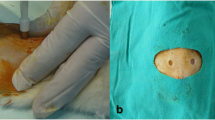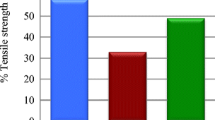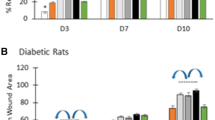Abstract
Diethyl maleate (DEM) which binds and thus depletes tissue glutathione levels was used to aggravate the injury and to determine its effect on incisional healing. A 5 cm dorsal midline skin incision was performed on 40 albino Wistar rats in two groups and then closed by interrupted sutures. Groups received 0.9% NaCl and DEM at a dosage of 1 mg/kg/day intraperitoneally for seven days, respectively. On postoperative days 7 and 14, histopathological assessment and tensile strengths were measured. The DEM treated group had a marked inflammation with poorly defined collagen formation and the tensile strength measurements revealed a significant decrease (p <0.001) on the 7t day. On the other hand, the first group showed better collagenization and a lesser degree of inflammation. However, on the 14th day, there was no noticeable histopathological difference between the two groups; but, tensile strength values of the second group were still lower (p <0.05). In this animal model, DEM postponed the healing process and reduced the tensile strength.
Similar content being viewed by others
References
Deneke SM, Fanburg BL (1989) Regulation of cellular glutathione. Am J Physiol 257:163–175
Monnier DG, Fougeat S, Chaudiere (1992) Glutathione and cysteine depletion in rats and mice following acute intoxication with deithylmaleate. Biochem Pharmacol 43:451–456
Richardson RJ, Murphy SD (1975) Effect of glutathione depletion on tissue deposition of methylmercury in rats. Toxicol Appl Pharmacol 31:505–519
Adams JD, Lauterburg BH, Mitchell JR (1983) Plasma glutathione and glutathione disulfide in the rat: regulation and response to oxidative stress. Exp Ther 227:749–754
Kobayashi T, Robinson MK, Robinson V, DeRosa E, Wilmore DW, Jacobs DO (1993) Glutathione depletion alters hepatocellular high-energy phosphate metabolism. J Surg Res 54:189–195
Maynard PM, Graupner WG, Bowe WG (1992) Effect of glutathione depletion on tissue and plasma prostacyclin and thromboxane in rats. Biochem Pharmacol 43:1043–1051
Madden JW, Peacock EE Jr (1968) Studies on the biology of collagen during wound healing. 1. Rate of collagen synthesis and deposition in cutaneous wounds of the rat. Surgery 64:288–294
Bernstein EF, Salomon GD, Harisiadis L, Talbot T, Harrigton F, Russo A, Uitto J (1993) Collagen gene expression and wound strength in normal and radiation-impaired wounds. Dermatol Surg Oncol 19:564–570
Viljanto J (1964) Biochemical basis of tensile strength in wound healing. An experimental study with viscose cellulose sponges on rats. Acta Chir Scand [Suppl] 333:1–101
Savunen TJA, Viljanto JA (1992) Prediction of wound tensile strength: an experimental study. Br J Surg 79:401–403
DelMaestro RF (1981) An approach to free radicals in medicine and biology. Acta Physiol Scand [Suppl] 492:153
Weiss SJ (1986) Oxygen, ischemia and inflammation. Acta Physiol Scand [Suppl] 548:9–37
White MJ, Heckler FR (1990) Oxygen free radicals and wound healing. Clin Plast Surg 17:473–484
Hogstrom H (1987) Mechanisms and prevention of decrease in wound margin strength in intestinal anastomoses and laparotomy wounds. Acta Chir Scand [Suppl] 539:1–63
Jahnson S, Graf W, Rikner G, Gerdin B (1995) Anastomotic breaking strength and healing of anastomoses in rat intestine with and without chronic radiation damage. Ent J Surg 161:425–430
Portnoy WM, Moscatello AL, Alfieri A, Hilaris BS, Tchelebi A, Pelton-Henrion K, McCormick SA (1993) Wound repair after fractionated external beam radiation therapy and concomitant hyperthermia in an experimental rat model. Cancer 71:3779–3782
Davidson SF, Brantley SK, Johnson SG, Hsu HS, Das SK (1992) The effects of ultraviolet irradiation on wound contraction in the hairless guinea pig. Br J Plast Surg 45:508–511
Davidson SF, Brantley SK, Das SK (1992) The reversibility of UV altered wound tensile strength in the hairless guinea pig following a 90-day recovery period. Br J Plast Surg 45:109–112
Meister A, Anderson ME (1983) Glutathione. Ann Rev Biochem 52:711–760
Robinson M, Rounds J, Hong R, Jacobs P, Wilmore D (1992) Glutathione deficiency increase organ dysfunction after hemorrhagic shock. Surgery 112:140–149
Author information
Authors and Affiliations
Rights and permissions
About this article
Cite this article
Yavuzer, R., Tascilar, Ö., Tekin, E. et al. Incisional healing in rats treated with diethyl maleate. Eur J Plast Surg 20, 306–309 (1997). https://doi.org/10.1007/BF01387856
Issue Date:
DOI: https://doi.org/10.1007/BF01387856




